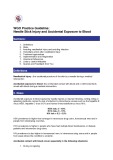


Avoiding infection
Xem 1-1 trên 1 kết quả Avoiding infection
-
Document presentation of content: Risks, avoiding needlestick injury and avoiding infection, immediate action after needlestick injury, treatment approaches, implementation and registration, literature references, links to useful websites.
 10p
10p  vovanvovan2013
vovanvovan2013
 13-05-2016
13-05-2016
 41
41
 2
2
 Download
Download
CHỦ ĐỀ BẠN MUỐN TÌM
TOP DOWNLOAD












